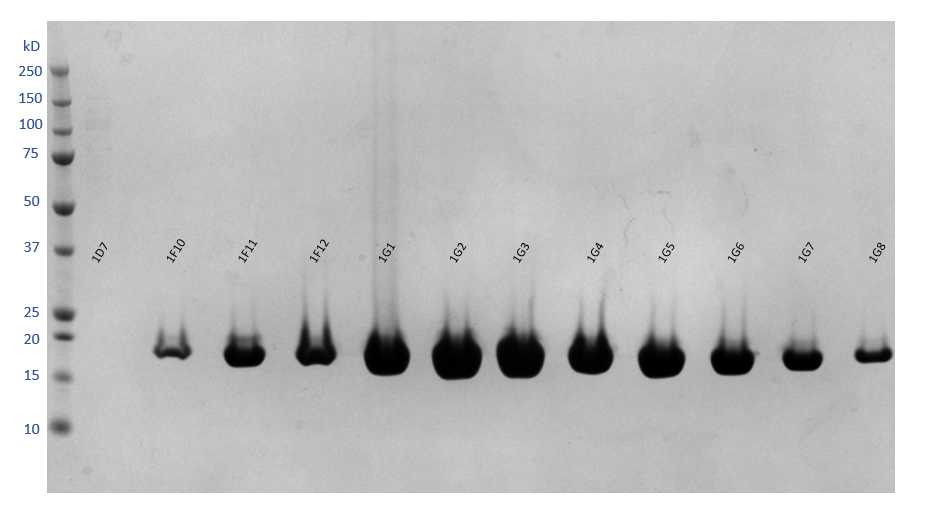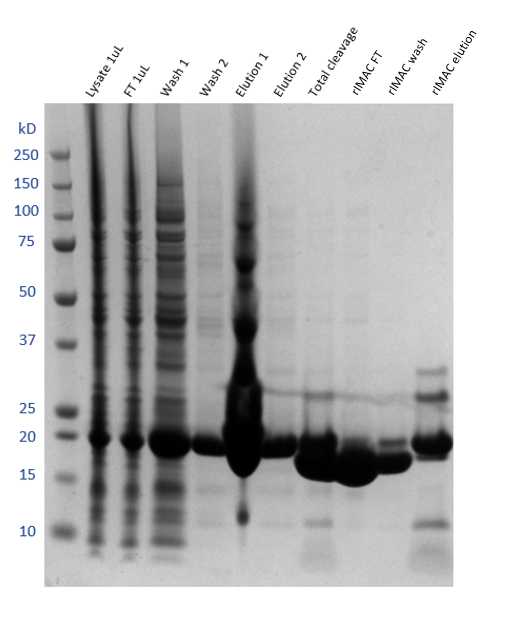SARS-CoV-2 nsp3 macrodomain expression and purification protocol for crystallization
Korvus Wang, michael fairhead, Eleanor Williams
expression
purification
ASAP
CMD
AViDD
SARS-CoV-2
SARS-CoV-2 nsp3
SARS-CoV-2 nsp3 macrodomain
SARS-CoV-2 macrodomain
nsp3 macrodomain
#nsp3
macrodomain
mac1
his-tag
Disclaimer
Research was supported in part by NIAID of the U.S National Institutes of Health under award number U19AI171399. The content is solely the responsibility of the authors and does not necessarily represent the official views of the National Institutes of Health.
Abstract
This protocol details the expression and purification of SARS-CoV-2 nsp3 macrodomain crystallization construct bearing a N-terminal His-tag at small scale (<6L).
Attachments
Steps
Abbreviations
CV - column volume, total volume of resin in a column
IMAC - immobilised metal affinity chromatography
FT - flow through
CVNSP3mac1 - SARS-CoV-2 nsp3 macrodomain
Plasmid Transformation
CVNSP3mac1 N-terminal His-tagged construct was inoculated from its BL21(DE3)-RR glycerol stock.
Protein expression
Scrape off some of the glycerol stock with a sterile loop and use this to inoculate a 50 mL falcon tube containing 10mL of LB supplemented with 50ug/mL kanamycin. Grow the starter culture at 37°C 4h 0m 0s with 200 rpm shaking.
Use the 10mL starter culture to inoculate 1L TB media (see Materials) supplemented with 50ug/mL kanamycin in a baffled flask. 200rpm
When the OD600 reaches approximately 1.4, reduce temperature to 18°C and incubate for an additional hour. Add 0.4millimolar (mM) IPTG. Lower shaker speed to 180rpm. Incubate .
Harvest the cell by centrifugation at 4000x g,4°C. Discard supernatant and store pellet by freezing at -80°C .
Protein Purifcation
Lyse cell pellet
Thaw and resuspend the pellet in ~7mL of lysis buffer per g of pellet. Stir gently with magnetic stir bar at Room temperature for 0h 30m 0s to allow lysozyme and bezonase to start breaking down
cell components.
Lyse by sonication 0h 0m 2s 0h 0m 4s for a total 'on' time of 0h 10m 0s at 40% amplitude to fully rupture the cells. Ensure pellet is °C during sonication to prevent overheating.
Centrifuge the lysed cells for 38000x g,4°C to remove insoluble cell debris, and collect supernatant in a bottle 4°C
Perform IMAC to extract target protein from the lysed cell mixture
Dispense 2mL Nickle affinity resin Ni Sepharose 6 FF - Cytiva into a gravity flow column. Equilibrate resin by first rinsing with ~ 10CV distilled water, then ~ 10CV binding buffer to remove the storage solution.
Resuspend the equilibrated resin with some binding buffer and add to the supernatant bottle. Incubate the resin with the supernatant for 1h 0m 0s while rotating or otherwise mixing gently at 4°C
Load the resin/supernatant mix back onto the gravity flow column, retaining the FT separately for SDS-PAGE analysis.
Wash the column with 10CV of base buffer, followed by 10CV of wash buffer twice. Allow wash buffer to pass through completely between washes. This is to remove non-specific, weak binding of contaminant proteins from the resin for a cleaner elution.
Collect washes separately for SDS-PAGE analysis.
Elute the protein with 7.5mL of elution buffer.
Repeat step 8.5 one more time, collecting a total of 2 separate elution fractions. This is to ensure maximum retrieval of protein from the resin.
Measure the total protein concentration of the elutions by Nanodrop. Although still a mixture, A280 value can give an estimate of the protein content, which will determine how much protease need to be added to remove the affinity tag.
Wash used IMAC resin with 10 CV of base buffer, and leave in the column submerged in a small amount of base buffer such that the resin is kept moist.
This washed IMAC resin will later be reused for reverse IMAC (rIMAC)
Run SDS-PAGE of all samples from total lysis supernatant to final elution. Stain gel with protein staining solution Coomasssie Blue and determine which fractions contain the target protein by finding the band corresponding to the target molecular weight.
Elution de-salting, tag cleavage and reverse IMAC
Pool the elutions and desalt using a HiPrep 26/10 deasalting column, run on an AKTA pure at a maximum flow rate of 10mL/min.
For tag removal, His-TEV was added in 1:20 ratio to the total protein content of the diluted sample, as determined by nanodrop. The mixture was left standing in the cold room at 4°C
In morning, pour the cleavage mixture over the washed resin three times and collect final FT.
(Optional) elute rIMAC resin with 2CV elution buffer to confirm if the protein shows non-specific binding to the resin used.
Purify sample further by size exclusion chromatography .
Using 10,000 MWCO spin concentrators, concentrate the rIMAC step containing fractions of the target protein to a final volume of under 5mL .
Remove any solid aggregates from the sample by centrifugation at 17200x g,4°C , then immediately draw up the supernatant with a 5mL syringe and a blunt-tip fill needle, taking care not to disturb the pellet.
Using the AKTA Pure system:
Inject the sample onto a 5 mL sample loop.
Run the sample down HiLoad 16/60 Superdex 75 pg gel filtration column at 1 mL/min in gel filtration buffer, collecting 1 mL aliquots.
From the chromatogram, fraction F9-H8 analyse by SDS-PAGE.


Take the fractions that contain the target protein, which in this case are fraction F9-G8. Concentrate the final sample in Vivaspin 500 10 kDa MWCO centrifugal concentrator until the concentration reaches >45mg/mL .
Take 1µL of the final sample for SDS-PAGE, which was not carried out here. However, intact MS confirms sample purity.

Aliquot into appropriate volumes for future usage to minimise freeze/thaw cycles. Flash-freeze in liquid nitrogen, and store at -80°C until required.


